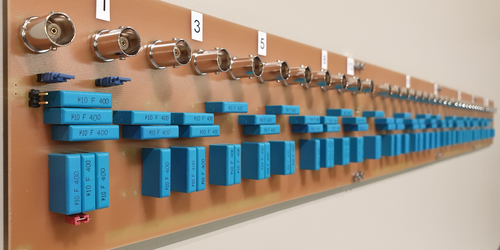A Simple Electronic Circuit Manifests a Complex Physical Effect
In atomic physics, a Fibonacci chain is a chain of atoms that contains two atom species, A and B. The B atoms are separated by either one or two A atoms in an irregular sequence. Thanks to the irregularity of the pattern, these Fibonacci chains are quasicrystals in which rich collective behaviors can emerge. Creating circuit analogs of atomic systems allows researchers to fashion Fibonacci chains from capacitors, inductors, and resistors. Now Selma Franca of the Institut Néel in France and her collaborators have built such an electronic Fibonacci chain from off-the shelf electronic components and have devised a simple way to characterize the chain’s complex physics [1].
Physicists can fruitfully analyze quasicrystals by adding a virtual dimension to the structures. For Fibonacci chains, that process takes one-dimensional structures and makes them two dimensional. With an appropriate choice of the dimensional projection procedure, this type of theoretical analysis can lead to equations for the behavior of Fibonacci chains that match those for two-dimensional quantum Hall systems, which have topologically protected edge states.
The electronic circuit of Franca and her collaborators consists of 34 interconnected “LC units”—smaller circuits that each contain an inductor and a capacitor. Driving the circuit with an alternating current, the team excited a spectrum of resonances including those related to the topological edge states of a two-dimensional quantum Hall system.
It used to be thought that mapping the resonances required sequential measurements of the impedance of each LC unit. Franca and her collaborators realized they could infer the entire set of energy levels of their system, including those of the edge states, from a single set of measurements. Although the researchers configured their circuit to mimic a quantum Hall system, they say that their approach has the potential to explore electronic counterparts of other complex systems.
–Charles Day
Charles Day is a Senior Editor for Physics Magazine.
References
- S. Franca et al., “Impedance spectroscopy of chiral symmetric topoelectrical circuits,” Phys. Rev. B 109, L241103 (2024).




